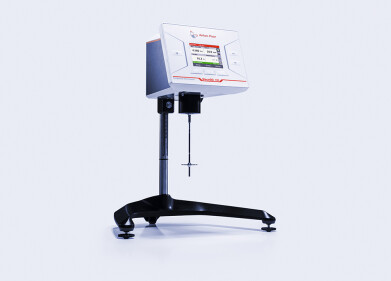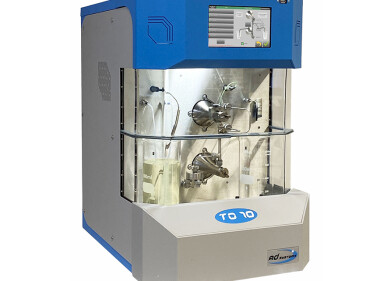Analytical instrumentation
Latest Breakthroughs in Petrochemistry
Feb 14 2022
For a few years now, PEFTEC has been one of the most popular conferences in Europe on petrochemical analytics, with regular attendees from over 95 countries. Conferences feature a diverse range of talks from professionals, academics, industrial experts and vendors, all of which focussed on the analysis and testing of petrochemicals.
At this year’s PEFTEC, a great wealth of recent advancements, new applications and technologies were presented. The conference was a unique opportunity to get to know the latest trends in petroleomics and to benefit from the latest knowledge.
Comprehensive Gas Chromatography
From Monash University, Australia, Professor Philip Marriott discussed the growth in the field of comprehensive gas chromatography, starting from developments in hardware and software, which is enabling the petrochemistry community to achieve reproducible and quantitative evaluation of complex samples. Prof. Marriott elaborated how industry has started harvesting the benefits of these developments, but a great many have yet to be explored. For example, leading-edge separation technologies and advanced solutions for detailed chemical analysis, whether it be multidimensional process analysers, supercritical fluid separations, or high-resolution capillary GC×GC-MS. Such advancements are usefully applied to crude oil samples, but the complexity of down-stream products means they remain opaque for the moment. Clearly, this is fertile ground for the development of innovative and powerful separation solutions.
Representing IFP France, Aleksandra Lelevic, Ph.D., demonstrated how the combination of vacuum ultraviolet spectroscopy with comprehensive gas chromatography may improve the quantitative analysis of gas oils – an essential procedure for assessing performance in relation to standards. Usually, in order to quantify for families which co-elute in comprehensive gas chromatography, analysts fractionate gas oil prior to analysis, but adding VUV spectroscopy to the process enables users to distinguish between most hydrocarbon families, rendering pre-fractionation unnecessary.
Mass Spectrometry
Lukas Friederici, Ph.D., introduced an advanced characterisation tool for mixed plastic waste: the hyphenation of thermal analysis to different mass spectrometric approaches. Mr. Friederici suggests that these methods can be used to explore the value of pyrolysis chars from low-density polyethylene as a feedstock for recycling plastic into batteries, catalysis, water purification or to generate further chemicals. Besides avoiding the perils of incineration, pyrolysis is also one of the most promising approaches for the recycling of solid plastic waste, as it generates a certain amount of solid residue besides liquid and gaseous products.
Another interesting presentation on mass spectrometry came from Charlotte Mase of Normandie University, which explored different ion sources in conjunction with fourier-transform ion cyclotron resonance mass spectrometry for the analysis of different plastic pyrolysis oils. These oils, which are produced from plastic waste materials, are sources of monomers, fuels and chemicals, thereby circumventing the problems of fossil resources and alleviating waste-disposal concerns. In order to improve essential conversion and valorisation processes, the advanced molecular description provided by the combination outlined by Ms. Mase is essential. Further, switching up ionization sources ensures an extensive molecular description and enables users to accurately assess the efficiency of different catalytic chemical treatments.
Spectroscopy: Thermal and Elemental
From France, Dr. Marion Lacoue-Nègre discussed the development of software that uses chemometric tools to predict the viscosity of base oil in hydro-cracked effluent. As a result, the software can obtain the performances of high-throughput testing experiments and to respond to the desire for analytical efficiency. Clearly, this is an improvement upon the traditional workflow, which is time-consuming and completely incompatible with high-throughput testing experiments, for which only a few millilitres are produced. The results presented by Dr. Lacoue-Nègre demonstrate that it is possible with such an approach to predict the ranking of catalytic systems.
Calling in from the United Arab Emirates, Dr. Girish Galgali covered the thermo-rheological analysis as a tool to characterize or differentiate linear low-density polyethylene in blends. Linear low-density polyethylene is the most widely used for flexible packaging application. The microstructure and properties of the thermoplastic are primarily influenced by parameters such as comonomer type, comonomer content and distribution, molecular weight and molecular weight-distribution. In a study, Dr. Galgali evaluated several linear low-density polyethylenes with comparable macro-parameters, such as density and melt-flow rate, using thermo-rheological tools. From rheological measurements, it was demonstrated that up to 30 wt.%, linear low-density polyethylenes was miscible with low-density polyethylenes. Dr. Galgali’s study also demonstrated that restricting oneself to relatively high comonomer content in the matrix of linear low-density polyethylene was not necessarily sufficient to achieve sealing at lower temperatures.
Recycling Plastics & related Analytics
Dr. Melissa Dunkle of Dow Chemical suggested that the American multinational is interested in certain pyrolysis oils – generated from waste plastics, via converting those as circular feedstocks. However, these alternative feeds are challenging options as drop-in replacements for fossil naphtha due to enormous impurities present in those feeds. To facilitate the application of these pyrolysis oils as circular feedstocks, Dr. Dunkle notes that deeper compositional understanding of the oils is required.
From the UK, Dr. Laura McGregor of SepSolve Analytics showed how the analysis of plastic has gained increased attention in recent years as a result of the global push to move to a circular economy. Manufacturers are being urged to produce or use more post-consumer recycled plastics but, as explained by Dr. McGregor, these plastics require more rigorous quality control measures to ensure that they do not emit volatiles that could be considered harmful, like malodours. However, there are several problems with the existing methods – such as, human sensory panels, eNose detection or GC-MS – of odour detection in plastic. Yet, Dr. McGregor identified TD–GC×GC–TOF MS as capable of drawing a confident characterization of complex odor profiles from recycled plastics, enabling fast and simple identification of the compounds causing quality control failures. Once the key odorants are known, methods can be easily converted into routine screening procedures in quality-control laboratories at production sites.
The Development of Instruments and Methods
Coen Duvekot from Agilent Technologies discussed recent micro-gas chromatography developments for out-of-lab and process applications, as well a new user-interface which is embedded in the hardware. The interface is accessible via a laptop or tablet, is easy to use and allows for quick, powerful method-development. It also allows for full calibration, integration, reporting, setting alarms and exporting results and data. With this full set of parameters, the micro-gas chromatograph doubles as a process-gas chromatograph, and makes the unit mobile enough to travel to the sample.
Jasmine Hertzog, Ph.D., calling in from the French headquarters of energy giant Total, took a look at the new research suggesting that bio-oils obtained from lignocellulosic biomass pyrolysis could be a suitable replacement for petroleum-based fuels. At the molecular level, these materials are highly complex mixtures comprising thousands of species, covering a large range of mass and polarity. They contain significant amounts of oxygenated compounds and water – which is responsible for corrosiveness and storage issues – as well as a low energetic density. Consequently, they cannot be directly used as biofuels, but must undergo upgrading processes in order to obtain a material whose physicochemical properties are close to conventional fuels. To improve these processes, Ms. Hertzog stressed that deep molecular characterization of bio-oils involving supercritical-fluid chromatography and ion-mobility mass spectrometry or direct-infusion, ultra-high-resolution mass spectrometry would be worth trying.
Process Analytical Technologies
Professor David Littlejohn from the University of Strathclyde reflected on the developments in analytical technology, many of which offer advantages in process and control. The petrochemical and oil sectors are well-accustomed to integrating analyser into processing and manufacturing plants for control of operations - industrial use of real-time or near-real-time measurements for process-optimization and control pre-dates similar developments in other sectors. In addition, Professor Littlejohn outlined the benefits of process-modelling through “soft sensors”, drawing examples from projects undertaken by the Centre for Process Analytics and Control Technology.
Speaking from France, Étienne Smith of ap2e outlined updates in standards for hydrogen fuel cells. It has been shown that even very low concentrations of gas impurities can cause non-negligible damages to fuel cell components. Thus, the publication of ISO 14687, in which multiple molecules have been identified as hazardous and highly restrictive concentration-thresholds determined. The standard establishes a few principles; in particular, when internal combustion engines can tolerate low-quality hydrogen, it is very important to inject high-quality hydrogen to prevent catalyst poisoning. Mr. Smith discussed the restrictions implied by the new standard and introduced an analytical solution for measuring impurities in hydrogen.
Panel discussion on ‘Plastic recycling & Petrochemistry Challenges’
Panel discussion session was chaired by Dr. Christopher Ruger from University of Rostock, Germany. Panel consisted of Dr. Maria Soliman from SABIC, Lars Meyer from BASF, Matthijs Ruitenbeek from DOW, Dr. Volodymyr Palchyp from Fraunhofer and Jules Magain from TotalEnergies. It gave the opportunity to different players in this field to share their current activities, short-/ long-term goals and ambitions on circular economy and carbon neutrality. Univocally, all the industry representatives stated that timeline set by their respective organizations on carbon neutrality is highly achievable. Being a producer of plastics, Industries also feel responsible to sincerely work on this aspect. There was a discussion on suitability of plastic waste as a feedstock. Panel confirmed that variability, inconsistency and impurities/ contaminations are the key aspects rendering difficulties to use plastic waste as a feed for polymer production. Even, same facility involved in plastic waste collecting, sorting, and pyrolyzing/ refining, resulted huge fluctuation in composition due to undefined and unpredictable value chain of the waste making it difficult to design a consistent industrial process of recycling the plastic waste. From analytical standpoint it brings one of the most challenging aspect – dealing with sample in-homogeneity. Representative sampling becomes almost impossible particularly for analytical tools requiring few milligram to few microgram for analysis. Panel opined that developing homogenization tool and benchmarking the process is the way forward to tackle the issue. It was pointed out by some of the industry representatives that having a long history working with fossil feeds, our expectations and practices are so far similar to that of fossil feeds, particularly when it comes to checking the specification as a feed. However, the MPW based feeds surprises us from different directions- diverse composition, new classes of compounds not observed before, wide array of impurities/ contaminants etc. Halogens like Br, Cl, as well Si are becoming a new target of attention. Both organic and inorganic content analysis has become essential and needs to be addressed by developing analytical protocols. A lot of analytical developments is required and expected to happen in coming years for characterization of those impurities. It will enable development of specification on new feed which is not existing currently. Close collaboration among waste collectors, sorting facility, converters, petrochemical industry and research organizations is very essential to make this approach successful. Besides these, panel also highlighted the importance of design for recyclability and multi-use/ durable plastic applications to consider while addressing the plastic recycling.
If you are interested in PEFTEC please go to our website.
Digital Edition
PIN 25.5 Oct/Nov 2024
November 2024
Analytical Instrumentation - Picturing Viscosity – How Can a Viscometer or a Rheometer Benefit You? - Sustainable Grease Formulations: Evaluating Key Performance Parameters and Testing Method...
View all digital editions
Events
Jan 20 2025 San Diego, CA, USA
Jan 22 2025 Tokyo, Japan
Jan 25 2025 San Diego, CA, USA
SPE Hydraulic Fracturing Technology Conference and Exhibition
Feb 04 2025 The Woodlands, TX, USA
Feb 05 2025 Guangzhou, China



















